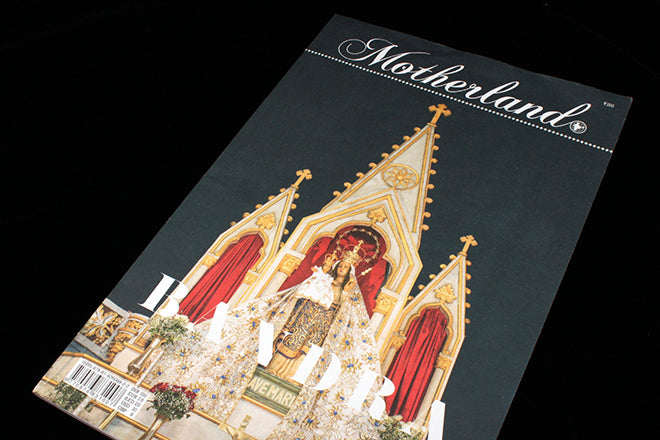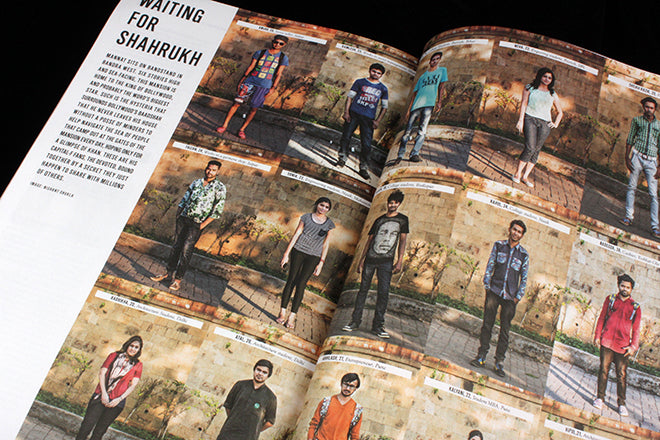
Motherland #14
The magazine format is a well suited to portraiture, whether a portrait of a person, a place or even an idea. As Boat, Cereal, Lost and many other place-orientated publications beautifully convey, a magazine’s shape and flow is conducive to delving into a particular city or country and digging out its stories through words, images and titbits.
The new ‘Bandra’ issue of Delhi-based Motherland has taken the ‘place-portrait’ approach: the pages explore the district of Bandra, a.k.a ‘The Queen of Suburbs’, an area that has transformed from sleepy fishing village to a ‘Catholic refuge’ to ‘Bollywood’s playground’ over the centuries. Now, the area is rampantly redeveloping - a familiar story - and Motherland digs deep into these changes in the community with anthropologically engaged in-depth reportage. It’s a combination that creates a kind of Flaneur-meets-Makeshift magazine.
Unlike the Boats and Cereals of independent publishing, it’s rare that ‘portrait-of-a-place’ is entirely edited by the people that actually live there – so the new issue of Motherland is special in that respect. The past issues have had wide-ranging and abstract themes like ‘Military’, ‘Skin’, ‘Ghost Stories’ and ‘Borders’ – yet always with the focus of contemporary Indian culture and society to bind the content together.
 Published by global agency Wieden+Kennedy since 2010 and edited by Vandana Verma, the magazine is available throughout India and at the country’s major airports; they aim to document contemporary India, it’s evolving traditions, it’s daily rituals, it’s deep-rooted histories and it’s cultural subversions. A swirling purple border decorating the pages (above) references the Indian Rupee currency – little design elements like this seek to subtly steep the magazine in the atmosphere of life in India without resorting to visual cliché. The publication’s strangely elongated shape also visually pronounces that it is a magazine that sets out to do things differently.
Published by global agency Wieden+Kennedy since 2010 and edited by Vandana Verma, the magazine is available throughout India and at the country’s major airports; they aim to document contemporary India, it’s evolving traditions, it’s daily rituals, it’s deep-rooted histories and it’s cultural subversions. A swirling purple border decorating the pages (above) references the Indian Rupee currency – little design elements like this seek to subtly steep the magazine in the atmosphere of life in India without resorting to visual cliché. The publication’s strangely elongated shape also visually pronounces that it is a magazine that sets out to do things differently.
 Like Flaneur, the ‘Bandra’ issue digs into the things about a place that go unnoticed. A detailed long-essay about funeral directors becomes an intriguing thought-piece on ‘space’ – the article considers what burial means to a community where there is a constant scramble for room. Tranquil photographs of the animals living on the streets of Bandra (above) are beautifully still, a series of contemplative moments in what is described elsewhere as is a place of hectic movement. Another photographic spread of fans of a famous Bollywood star playfully documents the daily queues outside the actor’s mansion (below): another whimsical take on the routines of this eclectic district.
Like Flaneur, the ‘Bandra’ issue digs into the things about a place that go unnoticed. A detailed long-essay about funeral directors becomes an intriguing thought-piece on ‘space’ – the article considers what burial means to a community where there is a constant scramble for room. Tranquil photographs of the animals living on the streets of Bandra (above) are beautifully still, a series of contemplative moments in what is described elsewhere as is a place of hectic movement. Another photographic spread of fans of a famous Bollywood star playfully documents the daily queues outside the actor’s mansion (below): another whimsical take on the routines of this eclectic district.

 Like Makeshift, the magazine has a special knack for finding hidden stories. A profile on a club called Zenzi is also a curious history of the area, told from the perspective of zealous entrepreneurs. On powdery yellow paper, the story of an unnoticed death amidst a close-knit neighbourhood is combined with haunting, delicate illustrations (above) – another personal perspective on a place heaving with conflicting ideals and varying communal groups.
Like Makeshift, the magazine has a special knack for finding hidden stories. A profile on a club called Zenzi is also a curious history of the area, told from the perspective of zealous entrepreneurs. On powdery yellow paper, the story of an unnoticed death amidst a close-knit neighbourhood is combined with haunting, delicate illustrations (above) – another personal perspective on a place heaving with conflicting ideals and varying communal groups.
A third story about the district’s east side – a poor, neglected area – calls itself ‘A walking tour of the places where we rarely walk’. The journey is candid and universal to city-life, and little graphic hints – like the way the typography is pushed up right to the edge of the page (below) – convey the sensation the writer describes as he wanders through the edgier side of town.
 Scrolling through the stockists on their website, Motherland is mostly available in India, but you can also get hold of a copy in magazine havens like Do You Read Me? in Berlin and Foyles in London. Many of its articles are available online, though, and they are worth diving into – especially if you enjoy immersive storytelling and the kinds of personal perspectives heard on podcasts like The Moth. It’s a beautiful example of a magazine that conveys a sense of place in an almost novelistic way, drawing on the microcosms to create an overall portrait that is rich in insight.
Scrolling through the stockists on their website, Motherland is mostly available in India, but you can also get hold of a copy in magazine havens like Do You Read Me? in Berlin and Foyles in London. Many of its articles are available online, though, and they are worth diving into – especially if you enjoy immersive storytelling and the kinds of personal perspectives heard on podcasts like The Moth. It’s a beautiful example of a magazine that conveys a sense of place in an almost novelistic way, drawing on the microcosms to create an overall portrait that is rich in insight.
Creative director: V Sunil


